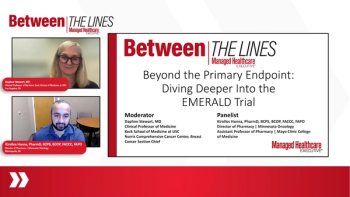
This segment summarizes practical guidance for patients, providers, and payers, emphasizing the need for comprehensive genomic testing and rapid access to targeted therapies.

This segment summarizes practical guidance for patients, providers, and payers, emphasizing the need for comprehensive genomic testing and rapid access to targeted therapies.

This segment analyzes key limitations of current evidence—including the non-randomized design of PHAROS and challenges of cross-trial comparison—while underscoring the ongoing need for better strategies in non-V600E mutations.

This segment examines treatment considerations for patients with CNS involvement, stressing individualized decisions due to limited dedicated CNS data for encorafenib/binimetinib in lung cancer.

A forward-looking analysis of how nonfactor therapies are transforming patient quality of life, clinician-patient collaboration, and the broader healthcare ecosystem for hemophilia management.

Sanofi introduces Qfitlia earlier this year, a groundbreaking hemophilia treatment, offering flexible dosing and support for patients transitioning from existing therapies.

Jeff Schaffnit discusses Sanofi's advancements in BTK inhibitors and promising results for hemophilia A therapies at ASH 2025, enhancing treatment options.

Clinicians are moving toward managing mild (Grade 1) cytokine release syndrome on an outpatient basis.

The CAR T Vision Steering Committee members wish to double the number of eligible patients receiving chimeric antigen receptor (CAR) T-cell therapy by 2030 through disease awareness and sustainable financing options, according to George Eastwood, Executive Director of the Emily Whitehead Foundation and recent CAR T Vision Steering Committee member.

As the number of patients with multiple myeloma and lymphoma treated with CAR-T therapy increases, health systems are shifting post-infusion care from inpatient to outpatient settings. Research presented at the annual meeting of the American Society of Hematology shows the change slices costs by $19,180.

Chimeric antigen receptor (CAR) T-cell therapy can cure certain types of blood cancer, but cost and a general lack of awareness around the therapy are barriers to care, according to George Eastwood, Executive Director of the Emily Whitehead Foundation.

This segment centers on key safety takeaways from the PHAROS study and how those findings influence real-world clinical practice when initiating BRAF-MEK-directed therapy.

This segment explores why multiple efficacy endpoints are essential when evaluating targeted therapies and transitions into a discussion of safety outcomes from the PHAROS study.

Early results from the LINKER-MM4 trial show high response rates for linvoseltamab, offering new hope for newly diagnosed patients.

Early results from the LINKER-MM4 trial reveal promising response rates for linvoseltamab in newly diagnosed multiple myeloma patients, with manageable side effects.

Focus on payer dynamics, cost, prior authorization processes, and the logistical aspects of transitioning patients from factor-based to nonfactor therapies, including adherence and at-home treatment implications.

This segment focuses on the efficacy results from the PHAROS phase II study, highlighting clear differences between treatment-naïve and previously treated patients with BRAF V600E-mutant NSCLC.

This segment reviews the design and patient characteristics of the PHAROS study, a phase II trial evaluating the BRAF-MEK inhibitor combination encorafenib and binimetinib in patients with BRAF V600E-mutant metastatic NSCLC.

Expert discusses how emerging technologies like at-home testing and AI are redefining CKD screening and prevention for the future.

Expert discusses how empowering patients with clear education on the heart-kidney connection drives better engagement and health outcomes.

The discussion focuses on the unique treatment approach for BRAF V600E–mutant NSCLC, which differs from other oncogenic drivers such as EGFR or ALK that are typically treated with single-agent targeted therapy.

This segment establishes the clinical context for BRAF V600E–mutant metastatic NSCLC, a relatively rare but clinically important subset of lung cancer.

Expert discusses how combining lifestyle and pharmacologic interventions effectively lowers cardiovascular risks and slows CKD progression.

Detailed discussion of Fitusiran, Marstacimab, and Concizumab, their mechanisms of action, differentiation from factor replacement, and highlights from key clinical trials (BASIS, ATLAS, Explorer 8).

Elacestrant significantly improved progression-free survival and maintained a manageable safety profile, especially benefiting patients with ESR1-mutated tumors.

Mark Nestor reveals groundbreaking insights on botulinum toxin's evolving science, enhancing its efficacy and expanding its medical applications in dermatology.

Discover how botulinum toxin injections in the glabella affect brain function, enhancing mood by altering emotional feedback from frowning.

Expert discusses how applying and adhering to established CKD screening guidelines ensures consistent, early detection and better outcomes across care settings.

Expert discusses how, despite its importance, albuminuria screening remains underutilized, and improving adherence to dual testing can transform early CKD detection.

Exploration of the emergence of nonfactor treatment classes, explaining how these agents function independently of missing clotting factors and their relevance to patient convenience, dosing, and efficacy.

Among chemotherapy-naive patients, elacestrant extended median progression-free survival compared with standard therapy, particularly in ESR1-mutated cases.